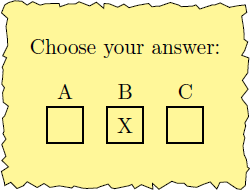Multiple multiple choice (100 follower special)

100 people were asked a multiple-choice question with three choices. Of these, 63 people gave the correct answer. Which statement can be made?
Assumptions: The participants can be divided into two groups. People in the first group know the right answer and always answer the question correctly. People of the second group only guess, so that their answers are purely random and all possible answers occur with equal probability.
This section requires Javascript.
You are seeing this because something didn't load right. We suggest you, (a) try
refreshing the page, (b) enabling javascript if it is disabled on your browser and,
finally, (c)
loading the
non-javascript version of this page
. We're sorry about the hassle.
There are L persons who know the right answer, and K persons who guess blindly. Of the second group, there are k people who happened to guess correctly. The probability of guessing correctly from three answer options is p = 1 / 3 . The variable k is binomial-distributed, so that the probability P ( k ) for exactly k correct answers is given by P ( k ) = k ! ( K − k ) ! K ! p k ( 1 − p ) K − k The expected value ⟨ k ⟩ and standard deviation σ k of this distribution are given by ⟨ k ⟩ σ k = K p = K p ( 1 − p ) Suppose it is L = K = 5 0 . Then the numbers results to ⟨ k ⟩ σ k ≈ 1 6 . 7 ≈ 3 . 3 In fact, there are L + k = 6 3 correct answers, so that in this case we have k = 1 3 . Thus, this value lies within the error interval ⟨ k ⟩ − σ k < k < ⟨ k ⟩ + σ k and fits perfectly with our assumption L = K = 5 0 . Therefore, we expect that the numbers L and K are approximately equal. At least no statement can be made as to which of the two groups is larger.